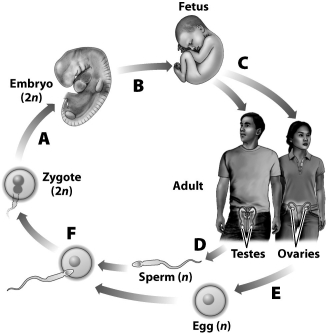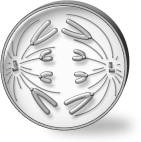A) two sister chromatids.
B) a single molecule of DNA combined with a large number of proteins.
C) the cell's karyotype.
D) its own spindle poles.
Correct Answer

verified
Correct Answer
verified
True/False
Cytokinesis occurs during interphase.
Correct Answer

verified
Correct Answer
verified
Short Answer
Many honeybee species are parthenogenic; unfertilized halpoid ____________________ develop to become haploid male bees called drones.
Correct Answer

verified
Correct Answer
verified
Short Answer
The attachment of microtubules to the centromeres of chromosomes during ____________________ of mitosis sets the stage for the positioning of the chromosomes at the metaphase plate.
Correct Answer

verified
Correct Answer
verified
Multiple Choice
Sexual and asexual reproduction can both offer distinct advantages under certain circumstances. In which of the following situations would asexual reproduction be disadvantageous?
A) Decomposers discover a dolphin carcass that had recently drifted to the ocean floor.
B) A persistently cooling climate results in a significant increase in average winter snow depth.
C) A cut breaches the defensive ability of the skin and infectious pathogens invade the injury.
D) Coastal currents, water temperature, nutrient concentrations, and light intensity temporarily combine to produce ideal growth conditions for marine phytoplankton.
Correct Answer

verified
Correct Answer
verified
Multiple Choice
The parthenogenetic whiptail lizards of the desert Southwest create no new genetic combinations during crossing-over, like other animals, because
A) all the crosses are double, eventually restoring each chromosome to its original condition.
B) they possess no homologous chromosomes; crossing-over in this species occurs between genetically identical sister chromatids.
C) parthenogenetic species forgo meiosis I, when crossing-over normally occurs.
D) accumulated mutation within the species has modified the centromeres, disrupted the formation of a bivalent, and prevented crossing-over from taking place.
Correct Answer

verified
Correct Answer
verified
True/False
Both meiosis I and meiosis II decrease the number of chromosomes found in a cell.
Correct Answer

verified
Correct Answer
verified
Short Answer
The most critical stage of interphase for a cell that needs to undergo cell division is the ____________________ phase. If the cell does not complete this phase, it cannot undergo DNA segregation.
Correct Answer

verified
Correct Answer
verified
Multiple Choice
What feature(s) distinguish an embryo from a zygote?
A) The cells of an embyro are diploid, whereas those of the zygote are haploid.
B) A zygote consists of a single cell, whereas an embryo is multicellular.
C) An embryo has differentiated to the extent that rudimentary organs are present, whereas a zygote's cells are still undifferentiated.
D) both a and c
Correct Answer

verified
Correct Answer
verified
Multiple Choice
Cancers are groups of cells that divide rapidly and uncontrollably. Thus cancer cells
A) are always in the G0 phase.
B) never enter the cell cycle.
C) have a relatively short G1 phase and ignore the G1 and G2 checkpoints.
D) are stuck at the metaphase plate.
Correct Answer

verified
Correct Answer
verified
True/False
The daughter cells of meiosis I are haploid.
Correct Answer

verified
Correct Answer
verified
Multiple Choice
The illustration below shows a summary of the events in the life cycle of a human. Which of the lettered transitions or events require mitosis? 
A) all but F
B) A, B, and C
C) D and E
D) F only
Correct Answer

verified
B
Correct Answer
verified
True/False
During meiosis I, the microtubules from only one spindle pole attach to only one member of a bivalent.
Correct Answer

verified
Correct Answer
verified
Multiple Choice
The successful union of one male and one female gamete forms a new single cell known as a
A) histone.
B) zygote.
C) vesicle.
D) gametocyte.
Correct Answer

verified
B
Correct Answer
verified
Multiple Choice
When examining the rapidly dividing cells of the onion root tip, you see a cell whose chromosomes are visible and are arranged in approximately the same size and shape as the nucleus. What stage of mitosis is this cell in?
A) metaphase
B) prophase
C) anaphase
D) telophase
Correct Answer

verified
B
Correct Answer
verified
Short Answer
The random distribution of chromosomes into daughter cells during ____________________ of meiosis is one way to create genetic diversity.
Correct Answer

verified
Correct Answer
verified
Multiple Choice
Which of the following foods is most likely to contain haploid cells?
A) a sirloin steak
B) an apple
C) an egg
D) a stalk of celery
Correct Answer

verified
Correct Answer
verified
Multiple Choice
Why must DNA be packed into chromosomes before mitosis or meiosis can occur?
A) In their unpacked state, the strands of DNA would be difficult to pull apart during cell division.
B) The zygote would be unable to live if the DNA were not packed into chromosomes.
C) We would be unable to see the karyotype if the DNA were not packed into chromosomes.
D) Some of the genes would escape during cell division if they were not packed tightly into chromosomes.
Correct Answer

verified
Correct Answer
verified
Multiple Choice
The cell depicted below has a diploid number of 8 (2n = 8) .  Assuming cell division started with a diploid cell, in what stage of what type of cell division is the cell?
Assuming cell division started with a diploid cell, in what stage of what type of cell division is the cell?
A) anaphase of mitosis
B) anaphase I of meiosis
C) anaphase II of meiosis
D) Both a and c are possible.
Correct Answer

verified
Correct Answer
verified
Multiple Choice
Gametes are produced by meiosis rather than mitosis because
A) mitosis would produce too many sister cells.
B) meiosis reduces the chromosome number so that zygotes produced will have one full genome.
C) meiosis doubles the chromosome number so that each gamete has twice the usual number of genes.
D) meiosis ensures that the gametes are identical to the cell that produced them.
Correct Answer

verified
Correct Answer
verified
Showing 1 - 20 of 89
Related Exams